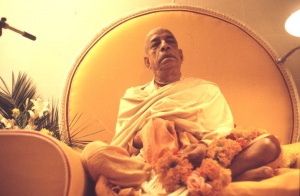CC Madhya 2.29 (1975)

A.C. Bhaktivedanta Swami Prabhupada
TEXT 29
- vaṁśī-gānāmṛta-dhāma, lāvaṇyāmṛta-janma-sthāna,
- ye nā dekhe se cāṅda vadana
- se nayane kibā kāja, paḍuka tāra muṇḍe vāja,
- se nayana rahe ki kāraṇa
SYNONYMS
vaṁśī-gāna-amṛta-dhāma—the abode of the nectar derived from the songs of the flute; lāvaṇya-amṛta-janma-sthāna—the birthplace of the nectar of beauty; ye—anyone who; nā—not; dekhe—sees; se—that; cāṅda—moonlike; vadana—face; se—those; nayane—eyes; kibā kāja—what is the use; paḍuka—let there be; tāra—his; muṇḍe—on the head; vāja—thunderbolt; se—those; nayana—eyes; rahe—keeps; ki—what; kāraṇa—reason.
TRANSLATION
"Of what use are eyes if one does not see the face of Kṛṣṇa, which resembles the moon and is the birthplace of all beauty and the reservoir of the nectarean songs of His flute? Oh, let a thunderbolt strike his head! Why does he keep such eyes?
PURPORT
The moonlike face of Kṛṣṇa is the reservoir of nectarean songs and the abode of His flute. It is also the root of all bodily beauty. If the eyes of the gopīs are not engaged in seeing the beautiful face of Kṛṣṇa, it is better that they be struck by a thunderbolt. For the gopīs, to see anything but Kṛṣṇa is uninteresting and, indeed, detestful. The gopīs are never pleased to see anything but Kṛṣṇa. The only solace for their eyes is the beautiful moonlike face of Kṛṣṇa, the worshipful object of all senses. When they cannot see the beautiful face of Kṛṣṇa, they actually see everything as vacant, and they desire to be struck by a thunderbolt. They do not find any reason to maintain their eyes when they are bereft of the beauty of Kṛṣṇa.